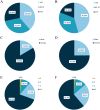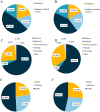Patient characteristics and adverse effects of allogeneic blood transfusion following lower extremity joint replacement in rheumatoid arthritis: a nationwide inpatient sample database study
- PMID: 40804428
- PMCID: PMC12345082
- DOI: 10.1186/s41927-025-00554-3
Patient characteristics and adverse effects of allogeneic blood transfusion following lower extremity joint replacement in rheumatoid arthritis: a nationwide inpatient sample database study
Abstract
Objectives: Allogeneic blood transfusion is a common therapeutic intervention for patients with rheumatoid arthritis (RA) undergoing lower extremity joint replacement (LEJR). Despite the potential for adverse outcomes associated with blood transfusion, the risks related to this procedure in RA patients remain underexplored, particularly within the framework of a large-scale national dataset.
Methods: This study analyzed data from the National Inpatient Sample (NIS) database from 2010 to 2019, identifying 66,674 patients diagnosed with RA who underwent LEJR. These cases were subsequently divided into two groups based on whether they received blood transfusion. Univariate and multivariate logistic regression analyses were conducted on patient demographics, the prevalence of comorbidities, hospital-level characteristics, total financial charges, insurance coverage, and in-hospital mortality rates.
Results: The cumulative blood transfusion rate among RA patients undergoing LEJR was 10.9%, showing a declining trend over the study period (from 23.79% in 2010 to 3.67% in 2019). Several factors were associated with an increased likelihood of receiving blood transfusion, including advanced age (≥ 65 years), female sex, deficiency anemia, chronic blood loss anemia, weight loss, coagulopathy, fluid and electrolyte imbalances, neurological disorders, pulmonary circulatory disturbances, congestive heart failure, chronic kidney disease, and uncomplicated diabetes. Moreover, patients who received blood transfusion demonstrated a higher risk of specific complications, including wound infection, acute myocardial infarction, pneumonia, acute kidney injury, urinary tract infection, postoperative delirium, deep vein thrombosis, lower limb nerve injury, sepsis, and respiratory failure.
Conclusion: Thorough preoperative assessment is essential for identifying RA patients who were more likely to receive blood transfusion and be subjected to adverse outcomes. Proactive interventions during the perioperative period, coupled with the implementation of a comprehensive blood management strategy, can optimize blood transfusion in RA patients after LEJR.
Keywords: Lower extremity joint replacement; Rheumatoid arthritis; Risk factors; Transfusion.
© 2025. The Author(s).
Conflict of interest statement
Declarations. Ethics approval and consent to participate: All methods were carried out in accordance with relevant guidelines and regulations. Waived or not applicable due to the nature of the study (de-identified clinical database). Consent for publication: Not applicable. Competing interests: The authors declare no competing interests.
Figures






Similar articles
-
Prescription of Controlled Substances: Benefits and Risks.2025 Jul 6. In: StatPearls [Internet]. Treasure Island (FL): StatPearls Publishing; 2025 Jan–. 2025 Jul 6. In: StatPearls [Internet]. Treasure Island (FL): StatPearls Publishing; 2025 Jan–. PMID: 30726003 Free Books & Documents.
-
Cell salvage for minimising perioperative allogeneic blood transfusion in adults undergoing elective surgery.Cochrane Database Syst Rev. 2023 Sep 8;9(9):CD001888. doi: 10.1002/14651858.CD001888.pub5. Cochrane Database Syst Rev. 2023. PMID: 37681564 Free PMC article.
-
Pharmacological interventions for the prevention of bleeding in people undergoing elective hip or knee surgery: a systematic review and network meta-analysis.Cochrane Database Syst Rev. 2024 Jan 16;1(1):CD013295. doi: 10.1002/14651858.CD013295.pub2. Cochrane Database Syst Rev. 2024. PMID: 38226724 Free PMC article.
-
High Risk of Venous Thromboembolism With Aspirin Prophylaxis After THA for High-riding Developmental Dysplasia of the Hip: A Retrospective, Comparative Study.Clin Orthop Relat Res. 2025 Jun 9. doi: 10.1097/CORR.0000000000003482. Online ahead of print. Clin Orthop Relat Res. 2025. PMID: 40536765
-
Preoperative blood transfusions for sickle cell disease.Cochrane Database Syst Rev. 2016 Apr 6;4(4):CD003149. doi: 10.1002/14651858.CD003149.pub3. Cochrane Database Syst Rev. 2016. Update in: Cochrane Database Syst Rev. 2020 Jul 2;7:CD003149. doi: 10.1002/14651858.CD003149.pub4. PMID: 27049331 Free PMC article. Updated.
References
-
- Cross M, et al. The global burden of rheumatoid arthritis: estimates from the global b urden of disease 2010 study. Ann Rheum Dis. 2014;73(7):1316–22. - PubMed
-
- Goodman SM, Ravi B, A.J.I.J.o.C G. Outcomes Rheumatoid Arthritis Patients Undergoing Total Joint Arthroplasty. 2014;9:585–93.
-
- Park JH, et al. Predictors of perioperative blood loss in total joint arthroplasty. J Bone Joint Surg Am Vol. 2013;95(19):1777–83. - PubMed
LinkOut - more resources
Full Text Sources

